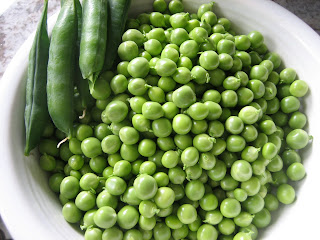The term "Beans" encompasses multiple types of plants and hundreds of varieties. According to one of my books, there are over 600 varieties available in the US. I'll focus here on Runner Beans and Green Beans.
Unlike Old World beans like garbanzos and fava beans, Runner Beans and Green Beans are from the New World, Central and South America. There is evidence that Green Beans have been cultivated for more than 8000 years. They were brought back to europe in the 16th century by the Spanish explorers.
These beans are easy to grow as long as you plant them in the late Spring after the soil has warmed up to at least 55 degrees. It helps if the daily air temperature is on the rise also. We wait to plant until late May or early June. You could plant earlier with the help of a poly tunnel or row cover over your plot. Also beware that deer like to eat bean plants. The ones that we had planted in our parking strip last year were browsed upon a couple of time. They thankfully recovered.
Runner Beans (Phaseolus coccineus) aka Scarlet Runner Bean are often grown primarily for their beautiful flowers, but the young pods and fresh seeds are eaten as well. They can grow 6 to 10 feet tall so a structure is needed to support them. A little creativity can make for a beautiful display.
Green Beans (Phaseolus vulgaris) aka French, Wax, Bush, Snap, String; filet; flageolet; Haricot; Haricot vert; Kidney, black, navy, pinto, etc. Phaseolus vulgaris are the common beans that most of us are familiar with. Why are they called French beans? French Huguenot refugees first grew beans in Britain in the 1500s.
All the different names for green beans can be confusing, but it is helpful to know the basics when reading recipes, especially for French and European dishes. The french call the dried seeds, haricots, and the young pods, haricots verts. French snap bean varieties that are picked when the pods are thin are called filet beans. The pods and small immature beans are called flageolets.
In the US, we know Phaseolus vulgaris as green shell, snap, or string beans.
Wondering how to choose which type to grow? Look at seed catalogues. You'll be amazed at the array. In seed catalogues you'll find green beans divided by bush and pole varieties. Bush varieties were developed to make for easy commercial and mechanical processing. They tend to come on early and with a short harvest period which is great if you plan on canning. You need plenty of space to grow enough to process. Pole varieties need a structure to grow on and while they start producing later than bush types they keep producing throughout the growing season as long as you keep picking the pods before they mature.
 |
| Blue Lake Pole |
In our kitchen garden, we've grown both bush and pole beans. We prefer pole beans because of the extended harvest and because you can grow a large quantity in a pretty small amount of space. The last two years we've grown Blue Lake pole beans, we planted way too many and were overwhelmed trying to keep up with them. We blanched and froze the extras which were not as tasty as fresh. Last year, we tried growing bush shelling beans for the first time. It was fun to just let the beans dry on the vines and collect the dried pods, shell them and put them in the jar in cupboard for our fall soups and stews.
 |
| Horto Semi-Bush |
This year we are growing: Pole Beans- Fortex (Green Bean), Bingo (Dry Shelling Bean) and Blue Lake. Also, Horto Semi-Bush (Dry Shelling Bean) and Yardlong Asparagus which is not a true bean, but is Vigna sesquipedalis.
What beans are you all growing this year? Have you grown Yardlong beans before? Do they really taste like Asparagus?















